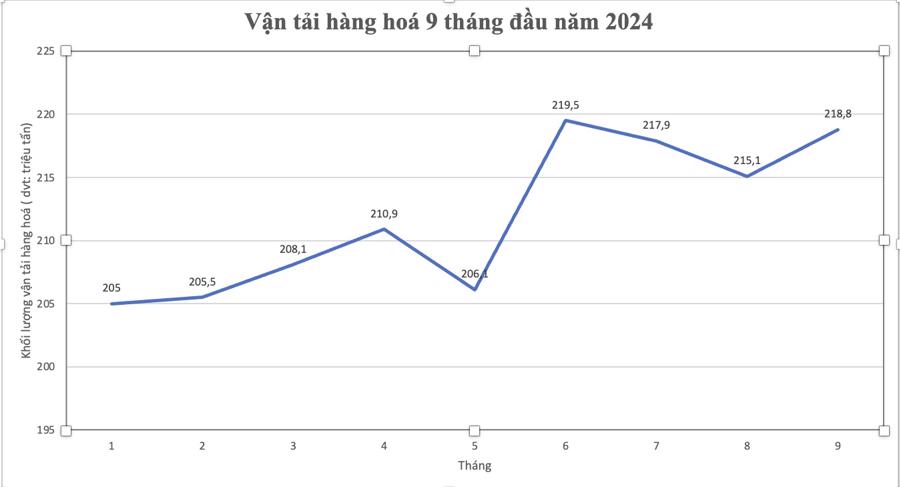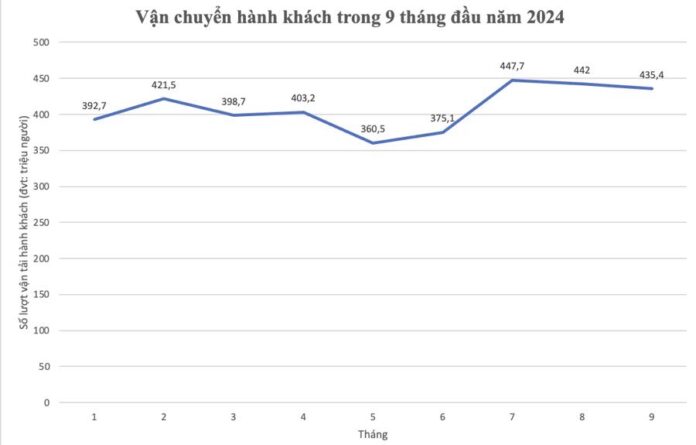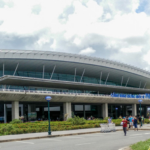For 2024, the Ministry of Transport sets ambitious targets for freight and passenger transportation, aiming for a 7% increase in freight volume (approximately 2.5 billion tons) and an 8% rise in passenger transportation (about 5 billion passengers) compared to 2023. Additionally, they seek to enhance cargo and passenger turnover by 8.5% (around 905 billion ton-km) and 9% (about 269 billion passenger-km), respectively.
As of the third quarter of 2024, statistics reveal a steady progression towards these goals. Passenger transportation has witnessed a 9% increase in volume and an impressive 18% surge in turnover compared to the same period last year. Freight transportation has also seen substantial growth, with a 12.6% rise in volume and a 7.3% increase in turnover.
STABLE GROWTH IN PASSENGER TRANSPORTATION
Delving into passenger transportation for September 2024, estimates indicate approximately 435.4 million passengers and a turnover of 23.5 billion passenger-km. This reflects a slight increase of 0.6% in volume and 0.9% in turnover compared to August 2024.
The third quarter of 2024 witnessed a notable rise, recording 1.3017 billion passenger movements, representing a 9.4% increase compared to the previous year. Turnover also showed a substantial improvement, estimated at 70.9 billion passenger-km, a 12.6% jump.
For the first nine months of 2024, passenger transportation reached an estimated 3.6602 billion passengers, indicating a 7.4% increase compared to the same period in 2023 (compared to a 13.2% increase in 2023). Turnover for this period hit 204.6 billion passenger-km, reflecting a notable 12.2% rise (compared to a 26.7% increase in the previous year).

According to the General Statistics Office, domestic passenger transportation reached an estimated 3.6468 billion passengers, a 7.4% increase, with a turnover of 161.4 billion passenger-km, up by 8.1%. International passenger transportation also thrived, with a remarkable 13.4 million passengers, a 19.2% increase, and a turnover of 43.2 billion passenger-km, up by 31.1%.
Analyzing different modes of passenger transportation, rail transport exhibited the highest growth rate compared to the previous year, surging by 17.8%. This was followed by inland waterway transport (9.3%) and sea transport (7.6%).
Road transport, despite accounting for 91.18% of total passenger movements with 3.3375 billion passengers, showed a more modest increase of 7.5% compared to the same period last year.
On the other hand, the aviation sector faced challenges, with an estimated 40.7 million passengers, reflecting a 5.9% decrease compared to the same period in 2023 (44.7 million passengers). This downturn can be attributed to rising fuel costs, leading to higher airfares and subsequently dampening travel demand.
SIGNIFICANT GROWTH IN AIR FREIGHT TRANSPORTATION
Turning to freight transportation, September 2024 witnessed an estimated 218.8 million tons of cargo transported, a slight decrease of 0.6% compared to the previous month. Turnover also dipped by 1.7%, reaching 44.9 billion ton-km. However, the third quarter of 2024 showed promising results, with an estimated 659 million tons of cargo transported, a substantial 14.7% increase year-on-year, and a turnover of 136.5 billion ton-km, up by 9.3%.
For the first nine months of 2024, freight transportation reached an impressive 1.9179 billion tons, reflecting a 13.7% increase compared to the same period in 2023 (a 14.6% increase in 2023). Turnover also rose by 10.5%, reaching 393.4 billion ton-km (compared to an 11.3% increase in the previous year).
Domestic freight transportation played a significant role, with an estimated 1.8834 billion tons transported, a 13.9% increase, and a turnover of 238.8 billion ton-km, up by 6.6%. International freight transportation also contributed, with 34.5 million tons transported, a 4.3% increase, and a substantial turnover increase of 17.2%, reaching 154.6 billion ton-km.

Statistics highlight a notable 40.9% increase in air cargo transportation compared to the same period last year (0.3 million tons). This marks the highest growth rate since 2021, indicating a robust recovery in air cargo transportation post-Covid-19. According to the General Statistics Office, one contributing factor is the strong growth in Vietnam’s exports of electronic components and high-value goods in the first months of the year.
Following the aviation sector, sea transport demonstrated impressive growth. During the first nine months of 2024, sea transport handled an estimated 101.2 million tons of cargo, reflecting a 16.1% increase compared to the same period in 2023.
Road transport, accounting for 74.16% of total cargo movements in the first nine months of 2024, showed a significant increase of 14.7%, handling an estimated 1.4223 billion tons.
Inland waterway transport and rail transport trailed in terms of growth rate, with 9.4% and 5.9% increases, respectively. They handled 390.5 million tons and 3.6 million tons of cargo during this period.
MEETING PEAK DEMAND IN THE FINAL QUARTER
As the fourth quarter of 2024 commences, Vietnam’s transport industry is poised for robust growth, setting the stage to accomplish its annual targets. Experts anticipate a surge in freight and passenger transportation during the year-end festive season, driven by heightened production, trade, export, and consumer activities.
To cater to the anticipated spike in passenger demand, Mr. Nguyen Van Thang, the Minister of Transport, has instructed relevant units to devise transport plans, harmonize various transport modes, enhance transport management, minimize delays and cancellations, and regulate slot allocation and airfare pricing. These measures aim to ensure sufficient transport capacity and stable ticket prices, providing convenience to travelers.
Vietnamese airlines have proactively initiated early ticket sales for the upcoming Tet holiday and are preparing to add new aircraft to their fleets to meet the rising demand. Tan Son Nhat International Airport has also adjusted its take-off and landing slots to enable airlines to plan their operations effectively for the year-end and Tet holiday rush. Similarly, the railway sector has commenced early ticket sales for Tet, witnessing robust demand with over 63,000 tickets sold within the first two weeks.

In the freight sector, the growth of e-commerce and the global economic recovery post-Covid-19 have presented positive opportunities for logistics. Major maritime transport companies have invested in large-capacity vessels to enhance their cargo-handling capabilities. For instance, PV Trans plans to invest in 2-4 specialized vessels, while Gas Shipping has secured a VND 240 billion credit agreement with Shinhan Bank Vietnam to purchase an LPG carrier with a capacity of approximately 5,000 CBM.
While targeting quantitative growth, experts emphasize the need to address the challenge of restructuring the market share of various transport modes in Vietnam. According to Mr. Nguyen Danh Huy, the Deputy Minister of Transport, there is an imbalance, with airlines operating on short-haul routes that may not generate sufficient revenue to cover costs. Similarly, on the North-South route, long-distance bus journeys persist, leading to longer travel times and potential safety risks.
Road safety remains a critical concern, with 17,629 traffic accidents reported nationwide in the first nine months of 2024, resulting in 8,045 deaths and 13,167 injuries. Compared to the same period last year, the number of accidents increased by 7.2%, while the number of fatalities decreased by 9.7%, and the number of injuries rose by 17.4%.
Moving forward, the Ministry of Transport aims to continue restructuring the transport sector to address imbalances, enhance efficiency and quality, invest in infrastructure, and reduce logistics costs in freight transportation.
The Chairman of TTC AgriS: Working in the Interests of 91% of Shareholders and Investors
Amidst the growing interest from international investors and prominent financial institutions in Thành Thành Công – Biên Hòa Joint Stock Company (TTC AgriS) (HOSE: SBT), Ms. Đặng Huỳnh Ức My, Chairperson of the company’s Board of Directors, has assured that fairness and transparency will be upheld for shareholders, investors, and all stakeholders.
Unlocking Investment Opportunities: Binh Duong’s ‘Transport-Led Development’ Strategy
By prioritizing investment in its transportation infrastructure, Binh Duong Province has successfully attracted a significant number of investors. Currently, the province is home to 71,776 domestic enterprises with a total registered capital of VND 786 trillion, along with 4,347 foreign-invested projects totaling US$42 billion in registered capital.
Accelerating Vietnam’s Infrastructure Dream: 600km of Expressways in the Mekong Delta by 2025
On October 16th, Prime Minister Pham Minh Chinh chaired a conference in Can Tho to address challenges and promote the development of transport infrastructure in the Mekong Delta region.











































